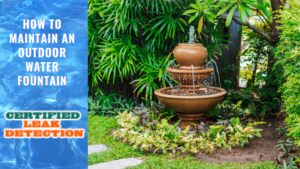
Whether it’s the showpiece of your front lawn, back yard or courtyard – or an accent to your landscaping – an outdoor water fountain increases the aesthetics of your property. However, regular maintenance is required to keep it a smoothly functioning thing of beauty for years to come.
While Certified Leak Detection does not perform fountain maintenance, we want you to get the most from the water-related features that enhance the beauty and enjoyment of your Central Florida home! Toward this end, we offer the following methods and tips for cleaning and maintaining your outdoor fountain.
Keeping Your Outdoor Water Fountain Clean
Obviously, your fountain is exposed to the elements, which necessitates cleaning it. The good people at Serenity Health & Home Décor point out that cleaning the fountain pump is essential to keep it in good working condition.
“To clean the pump thoroughly, take it out of the fountain and wipe away any debris or build-up with a cloth. Open the cover and wipe down the inside of the pump, as well. Any hard-to-reach areas can be cleaned out with an old toothbrush. Just a few minutes of pump maintenance will keep your fountain running smoothly and beautifully for a long time to come.”
Other tasks to perform include the following:
Removing debris – Central Florida’s summer afternoon thunderstorms can deposit leaves, twigs, sand, dirt, etc. into outdoor fountains – which can clog the pump. Debris can also build up when the fountain is left off for days at a time.
Cleaning scale build-up – White scale is a calcium buildup that develops from hard water. A simple, environmentally friendly solution is to rub the buildup gently with white vinegar and run the fountain afterward to rinse. Cleaning products specifically for outdoor fountains are also available, but be sure that they’re non-toxic to birds and other wildlife.
Using an algaecide – Algae can grow in fountains that aren’t run regularly. Algae can damage the surface of your fountain and may also clog the pump. Adding an algaecide will prevent its growth, but again, be sure it’s safe for birds and other wildlife. Some products are toxic to fish, so read the label if your fountain feeds into a fish pond. Chlorine is not recommended, as it’s hard on the fountain’s pump, but could be necessary to disinfect the system in the case of an algae bloom. In such a situation, add ¼ cup of chlorine bleach for every five gallons of water, and let the pump run overnight.
Cleaning up after birds – Depending upon the location of your property – as well as the presence of plants and insects popular as bird food – your fountain may be a favorite rest stop for our feathered friends. Because outdoor fountains can be made of concrete, stone or metal, follow the cleaning instructions provided by the manufacturer or company that installed it.
Keeping Your Outdoor Water Fountain Running
As mentioned earlier, cleaning the fountain’s pump is an important part of maintenance. Other duties to perform include the following:
- Remove the water once a month. You can use a wet/dry vacuum to take it out completely. Once the fountain is empty, wipe the interior with a soft cloth. Next, scrub off buildup with vinegar and a soft nylon brush, then wipe clean and refill the water.
- Place a nylon stocking over the pump and its intake area to prevent dirt from entering.
- Don’t let the fountain pump run dry. The pump can overheat if the water level drops significantly – which could easily happen during hot, dry weather.
Signs of Outdoor Water Fountain Leaks
Your water fountain needs to hold water to run smoothly. However, if there is a leak in your fountain, it will start losing water. Any unusual loss of water other than evaporation should raise a red flag. Our blog post – “How to Handle Problems With Your Outdoor Water Feature” – provides some troubleshooting steps to take to help you identify a possible leak.
One common sign of a fountain leak is a drop in water pressure; another is wet ground under the fountain, or water around the fountain base, if it’s installed on a concrete or brick surface. To check for leaks, turn off your fountain and fill it to the brim. If there is a leak, the water level will fall.
The Take-Home Message
Keeping your outdoor fountain a sparkling addition to your domestic oasis is worth the effort of diligent maintenance. When performed on a regular basis, you’ll avoid the additional work that’s necessary if you neglect it until the situation becomes unsightly and/or unsanitary.
Paying attention to your fountain will also help you notice problems before they get out of hand. If you suspect trouble, Certified Leak Detection is experienced in leak detection and repair for fountains, swimming pools, spas, and hot tubs, as well as slabs and foundations. Serving areas throughout Central Florida – including Orlando, Longwood, Lake Mary, Sanford, Kissimmee, Clermont and Winter Springs – our team is ready to answer your call. Contact us for quick, reliable service.

